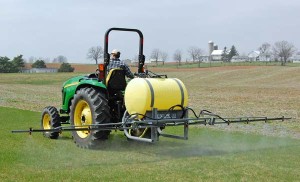Save Money by Calibrating Your Sprayer With These Guidelines (More Is Not Necessarily Better)
go.ncsu.edu/readext?405402
en Español / em Português
El inglés es el idioma de control de esta página. En la medida en que haya algún conflicto entre la traducción al inglés y la traducción, el inglés prevalece.
Al hacer clic en el enlace de traducción se activa un servicio de traducción gratuito para convertir la página al español. Al igual que con cualquier traducción por Internet, la conversión no es sensible al contexto y puede que no traduzca el texto en su significado original. NC State Extension no garantiza la exactitud del texto traducido. Por favor, tenga en cuenta que algunas aplicaciones y/o servicios pueden no funcionar como se espera cuando se traducen.
Português
Inglês é o idioma de controle desta página. Na medida que haja algum conflito entre o texto original em Inglês e a tradução, o Inglês prevalece.
Ao clicar no link de tradução, um serviço gratuito de tradução será ativado para converter a página para o Português. Como em qualquer tradução pela internet, a conversão não é sensivel ao contexto e pode não ocorrer a tradução para o significado orginal. O serviço de Extensão da Carolina do Norte (NC State Extension) não garante a exatidão do texto traduzido. Por favor, observe que algumas funções ou serviços podem não funcionar como esperado após a tradução.
English
English is the controlling language of this page. To the extent there is any conflict between the English text and the translation, English controls.
Clicking on the translation link activates a free translation service to convert the page to Spanish. As with any Internet translation, the conversion is not context-sensitive and may not translate the text to its original meaning. NC State Extension does not guarantee the accuracy of the translated text. Please note that some applications and/or services may not function as expected when translated.
Collapse ▲ With the recent spring weather, many calls have come into the office on how to mix herbicides to suppress or kill those springtime weeds. Most herbicide labels give directions in ounces, pints, quarts or gallons per acre. To correctly apply the right amount of herbicide, one will need to know how many acres you can spray with your particular size sprayer. Listed below is a simple way to calibrate (Boom or Boomless) your sprayer to be certain the amount you are applying per acre will do the job.
With the recent spring weather, many calls have come into the office on how to mix herbicides to suppress or kill those springtime weeds. Most herbicide labels give directions in ounces, pints, quarts or gallons per acre. To correctly apply the right amount of herbicide, one will need to know how many acres you can spray with your particular size sprayer. Listed below is a simple way to calibrate (Boom or Boomless) your sprayer to be certain the amount you are applying per acre will do the job.
Boom Sprayer Calibration:
- Determine nozzle spacing.
- Refer to the following chart to determine calibration course:
Nozzle Spacing Length of Calibration Course *
15″ 272′ 28” 146’
18″ 227′ 32” 127’
20″ 204′ 36” 113’
22″ 186′ 40” 102’
24″ 170′
- Measure and stake off the appropriate calibration course based on nozzle spacing. The course should be on the same type of ground that will be sprayed. (Speeds may be faster on roads than on sod, changing the application rate.)
- Drive the course in the gear and rpm you will use when actually spraying. Record the time in seconds. Do this twice and average the time.
- Park the tractor and maintain the same rpm.
- Turn on the sprayer and catch the water from one nozzle for exactly the same number of seconds that took to drive the calibration course.
- Ounces caught = gallons per acre.
- Check all nozzles. Flow rate should not vary more than 10% among all nozzles. Replace any nozzles that do not fall into this range.
* To determine calibration course for a nozzle spacing not listed, divide 340 by the spacing expressed in feet.
Example Calibration distance for 19-inch nozzle spacing = 340 divided by (19/12) = 215 feet.
Boomless Sprayer Calibration:
- Measure effective swath width.
- Refer to the following chart to determine calibration course:
Swath Width Length of Calibration Course *
35′ 157′
40′ 136′
45′ 121′
50′ 109′
- Measure and stake off the appropriate calibration course based on nozzle spacing. The course should be on the same type of ground that will be sprayed. (Speeds may be faster on roads than on sod, changing the application rate.)
- Drive the course in the gear and rpm you will use when actually spraying. Record the time in seconds. Do this twice and average the time.
- Park the tractor and maintain the same rpm.
- Turn on the sprayer and use a trash bag and bucket to catch the water for exactly the same number of seconds that it took to drive the calibration course. (Note: You can also use a 2-liter soda bottle, cut a hole in the side of the bottle, big enough to fit over the cluster nozzle, in place of a trash bag.)
- Pints caught = gallons per acre.
- Check all nozzles. Flow rate should not vary more than 10% among all nozzles. Replace any nozzles that do not fall into this range.
* To determine calibration course for a swath width not listed, divide 5460 square feet (1/8 acre) by the swath width in feet. Example Calibration distance for 32- foot swath width = 5460 divided by 32 = 171 feet.
If I can be of assistance, please call me at 336-651-7348.




